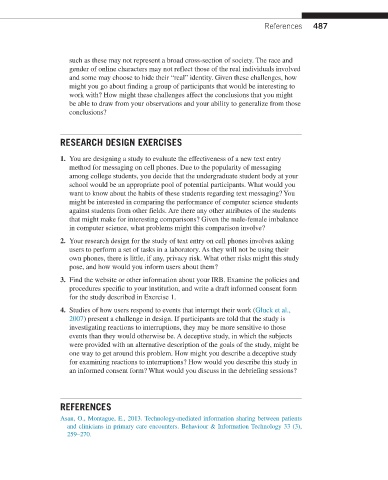Page 495 -
P. 495
References 487
such as these may not represent a broad cross-section of society. The race and
gender of online characters may not reflect those of the real individuals involved
and some may choose to hide their “real” identity. Given these challenges, how
might you go about finding a group of participants that would be interesting to
work with? How might these challenges affect the conclusions that you might
be able to draw from your observations and your ability to generalize from those
conclusions?
RESEARCH DESIGN EXERCISES
1. You are designing a study to evaluate the effectiveness of a new text entry
method for messaging on cell phones. Due to the popularity of messaging
among college students, you decide that the undergraduate student body at your
school would be an appropriate pool of potential participants. What would you
want to know about the habits of these students regarding text messaging? You
might be interested in comparing the performance of computer science students
against students from other fields. Are there any other attributes of the students
that might make for interesting comparisons? Given the male-female imbalance
in computer science, what problems might this comparison involve?
2. Your research design for the study of text entry on cell phones involves asking
users to perform a set of tasks in a laboratory. As they will not be using their
own phones, there is little, if any, privacy risk. What other risks might this study
pose, and how would you inform users about them?
3. Find the website or other information about your IRB. Examine the policies and
procedures specific to your institution, and write a draft informed consent form
for the study described in Exercise 1.
4. Studies of how users respond to events that interrupt their work (Gluck et al.,
2007) present a challenge in design. If participants are told that the study is
investigating reactions to interruptions, they may be more sensitive to those
events than they would otherwise be. A deceptive study, in which the subjects
were provided with an alternative description of the goals of the study, might be
one way to get around this problem. How might you describe a deceptive study
for examining reactions to interruptions? How would you describe this study in
an informed consent form? What would you discuss in the debriefing sessions?
REFERENCES
Asan, O., Montague, E., 2013. Technology-mediated information sharing between patients
and clinicians in primary care encounters. Behaviour & Information Technology 33 (3),
259–270.

